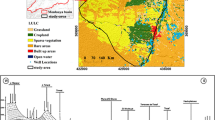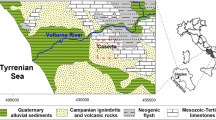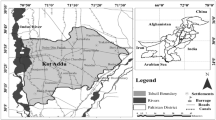Abstract
The groundwater vulnerability indices are valuable tools for the development of agrochemicals management strategies based on environmental/agricultural policies. The groundwater vulnerability methods of LOS, SINTACS, DRASTIC, Pesticide DRASTIC, GOD and AVI were applied for the agricultural fields of Sarigkiol basin (Northern Greece). The results of the aforementioned methods were examined and discussed in order to show how the dissimilarities in the vulnerability assessment approaches may become an advantage. The results of the methods were used to propose a combined conceptual approach which adds another two dimensions (depth and time) in the current two-dimensional vulnerability mapping (longitude, latitude) procedures. The LOS method provided information about the intrinsic vulnerability of the topsoil (30 cm) to water (+conservative pollutants) and nitrogen losses, and the AVI method described the vulnerability of the unsaturated zone to allow pollutants to reach the aquifer while the aquifer vulnerability was analysed using SINTACS, DRASTIC, Pesticide DRASTIC and GOD. In this study, the results of the SINTACS method were found more accurate to describe the local aquifer conditions. The final conceptual approach provided a stratified vulnerability (dimension of depth) of the overall hydrogeologic system using LOS for the topsoil, AVI for unsaturated zone and SINTACS for the aquifer. The dimension of time was introduced by the LOS and AVI methods, which provide quantitative results in time. The use of LOS method also highlighted the basic limitation of the other methods to describe the potential contribution to pollution of areas (especially upland areas) which are out of the aquifer boundaries.




Similar content being viewed by others
References
Aller L, Bennett T, Lehr JH, Petty RJ, Hackett G (1987) DRASTIC: a standardized system for evaluating ground water pollution potential using hydrogeologic settings: NWWA/EPA Series, EPA-600/2–87-035
Aschonitis VG, Mastrocicco M, Colombani N, Salemi E, Kazakis N, Voudouris K, Castaldelli G (2012) Assessment of the intrinsic vulnerability of agricultural land to water and nitrogen losses, via deterministic approach and regression analysis. Water Air Soil Pollut 223(4):1605–1614. doi:10.1007/s11270-011-0968-5
Aschonitis VG, Salemi E, Colombani N, Castaldelli G, Mastrocicco M (2013) Formulation of indices to describe intrinsic nitrogen transformation rates for the implementation of best management practices in agricultural lands. Water Air Soil Pollut 224:1489. doi:10.1007/s11270-013-1489-1
Aschonitis VG, Mastrocicco M, Colombani N, Salemi E, Castaldelli G (2014) Assessment of the intrinsic vulnerability of agricultural land to water and nitrogen losses: case studies in Italy and Greece. Proc Int Assoc Hydrol Sci 364:14–19
Aveline A, Rousseau ML, Guichard L, Laurent M, Bockstaller C (2009) Evaluating an environmental indicator: case study of MERLIN, a method for assessing the risk of nitrate leaching. Agric Syst 100:22–30. doi:10.1016/j.agsy.2008.12.001
Birkinshaw SJ, Ewen J (2000) Nitrogen transformation component for SHETRAN catchment nitrate transport modelling. J Hydrol 230(1):1–17. doi:10.1016/S0022-1694(00)00174-8
Bouwer H (1997) Role of groundwater recharge and water reuse in integrated water management. Arab J Sci Eng 22(1):123–131
Castaldelli G, Soana E, Racchetti E, Pierobon E, Mastrocicco M, Tesini E, Fano EA, Bartoli M (2013) Nitrogen budget in a lowland coastal area within the Po river basin (northern Italy): multiple evidences of equilibrium between sources and internal sinks. Environ Manag 52(3):567–580. doi:10.1007/s00267-013-0052-6
Civita M, De Maio M (2004) Assessing and mapping groundwater vulnerability to contamination: the Italian “combined” approach. Geofis Int 43(4):513–532
Civita M, De Maio M (1997) SINTACS – Un sistema parametrico per la valutazione e la cartografia della vulnerabilità degli acquiferi all'’nquinamento. Quaderni di tecniche di protezione ambientale, n. 60. Pitagora Editrice, Bologna
de Marsily G (2003) Importance of the maintenance of temporary ponds in arid climates for the recharge of groundwater. Compt Rendus Geosci 335(13):933–934. doi:10.1016/j.crte.2003.10.001
De Paz JM, Delgado JA, Ramos C, Shaffer MJ, Barbarick KK (2009) Use of a new GIS nitrogen index assessment tool for evaluation of nitrate leaching across a Mediterranean region. J Hydrol 365:183–194. doi:10.1016/j.jhydrol.2008.11.022
Foster SDD (1987) Vulnerability of soil and groundwater to pollutants. In: Van Duijvenbooden W, Waegeningh HD (eds) Proc TNO Comm Hydrogeol Res 38:69–86.
Galloway JN, Townsend AR, Erisman JW, Bekunda M, Cai Z, Freney JR, Martinelli LA, Seitzinger SP, Sutton MA (2008) Transformation of the nitrogen cycle: recent trends, questions, and potential solutions. Science 320(5878):889–892. doi:10.1126/science.1136674
Gogu R, Dassargues A (2000) Current trends and future challenges in groundwater vulnerability assessment using overlay and index methods. Environ Geol 39(6):549–559. doi:10.1007/s002540050466
Knisel WG, Davis FM (2000) GLEAMS, groundwater loading effects from agricultural management systems V3.0. Publ. No. SEWRL-WGK/FMD-050199. USDA, Tifton
Kruseman GP, Ridder NA (1990) Analysis and evaluation of pumping test data. ILRI publication, 47
Lasserre F, Razack M, Banton O (1999) A GIS-linked model for the assessment of nitrate contamination in groundwater. J Hydrol 224(3–4):81–90. doi:10.1016/S0022-1694(99)00130-4
Mastrocicco M, Colombani N, Castaldelli G, Jovanovic N (2011) Monitoring and modelling nitrate persistence in a shallow aquifer. Water Air Soil Pollut 217(1–4):83–93. doi:10.1007/s11270-010-0569-8
Morris BL, Lawrence ARL, Chilton PJC, Adams B, Calow RC, Klinck BA (2003) Groundwater and its susceptibility to degradation: a global assessment of the problem and options for management. Early warning and assessment report series, 03–3, United Nations Environment Programme, 126 pp
Neshat A, Pradhan B, Pirasteh S, Shafri HZM (2014) Estimating groundwater vulnerability to pollution using modified DRASTIC model in the Kerman agricultural area, Iran. Environ Earth Sci 71(7):3119–3131. doi:10.1007/s12665-013-2690-7
Neshat A, Pradhan B (2015a) An integrated DRASTIC model using probabilistic based frequency ratio and two new hybrid methods for groundwater vulnerability assessment. Nat Hazards 76(1):543–563. doi:10.1007/s11069-014-1503-y
Neshat A, Pradhan B (2015b) Risk assessment of groundwater pollution with a new methodological framework: application of Dempster-Shafer theory and GIS. Nat Hazards 78(3):1565–1585. doi:10.1007/s11069-015-1788-5
Neshat A, Pradhan B, Javadi S (2015) Risk assessment of groundwater pollution using Monte Carlo approach in an agricultural region: an example from Kerman Plain, Iran. Comput Environ Urban Syst 50:66–73. doi:10.1016/j.compenvurbsys.2014.11.004
Napolitano P, Fabbri AG (1996) Single-parameter sensitivity analysis for aquifer vulnerability assessment using DRASTIC and SINTACS. IAHS Publications-Series of Proceedings and Reports-Intern Assoc Hydrological Sciences, 235:559–566
Puckett LJ, Tesoriero AJ, Dubrovsky NM (2011) Nitrogen contamination of surficial aquifers—a growing legacy. Environ Sci Technol 45(3):839–844. doi:10.1021/es1038358
Refsgaard JC, Thorsen M, Jensen JB, Kleeschulte S, Hansen S (1999) Large scale modeling of groundwater contamination from nitrate leaching. J Hydrol 221:117–140. doi:10.1016/S0022-1694(99)00081-5
Salemi E, Colombani N, Aschonitis VG, Mastrocicco M (2011) Assessment of specific vulnerability to nitrates using LOS indices in the Ferrara Province, Italy. In: Advances in the research of aquatic environment. Springer, Berlin, pp. 283–290. doi:10.1007/978-3-642-24076-8_33
Shaffer MJ, Halvorson AD, Pierce FJ (1991) Nitrate leaching and economic analysis package (NLEAP): model description and application. In: Managing nitrogen for groundwater quality and farm profitability. Soil Science Society of America, Madison, pp. 285–322
Šimůnek J, van Genuchten MT, Šejna M (2008) The HYDRUS-1D software package for simulating the one-dimensional movement of water, heat, and multiple solutes in variably-saturated media. Version 4.0. HYDRUS Software Ser. 3. Dep. of Environmental Sciences, Univ. of California, Riverside
Tesoriero AJ, Duff JH, Saad DA, Spahr NE, Wolock DM (2013) Vulnerability of streams to legacy nitrate sources. Environ Sci Technol 47(8):3623–3629. doi:10.1021/es305026x
Van Stempvoort D, Ewert L, Wassenaar L (1992) AVI: a method for groundwater protection mapping in the prairie provinces of Canada. Prairie Provinces Water Board Report 1–14, Regina, SK
Voudouris KS (2006) Report on the hydro-meterological and hydro-geological data of Sarigkiol basin Kozani prefecture, Western Macedonia, Greece. Development and utilization of vulnerability maps for the monitoring and management of groundwater resources in the Archimed area (Water-Map) (eds) Polemio M, Dragone V, Watermap, Intereg III B Archimed, 8–21
Wang Y, Merkel BJ, Li Y, Ye H, Fu S, Ihm D (2007) Vulnerability of groundwater in Quaternary aquifers to organic contaminants: a case study in Wuhan City, China. Environ Geol 53(3):479–484. doi:10.1007/s00254-007-0669-y
Winter TC, Harvey JW, Franke OL, Alley WM (2013) Ground Water and Surface Water A Single Resource. USGS circular 1139
Zwahlen F (2003) Vulnerability and risk mapping for the protection of carbonate (karst) aquifers. Eur Comm Cost Action 620:42
Acknowledgments
We are grateful to an anonymous reviewer and to Professor Biswajeet Pradhan for their valuable comments and suggestions. The work presented in this paper was financially supported by the European Union, within EU.WATER project ‘Transnational integrated management of water resources in agriculture for the EUropean WATER emergency control’, of the South East Europe Programme (contract n. SEE/A/165/2.1/X).
Author information
Authors and Affiliations
Corresponding author
Rights and permissions
About this article
Cite this article
Aschonitis, V.G., Castaldelli, G., Colombani, N. et al. A combined methodology to assess the intrinsic vulnerability of aquifers to pollution from agrochemicals. Arab J Geosci 9, 503 (2016). https://doi.org/10.1007/s12517-016-2527-2
Received:
Accepted:
Published:
DOI: https://doi.org/10.1007/s12517-016-2527-2




